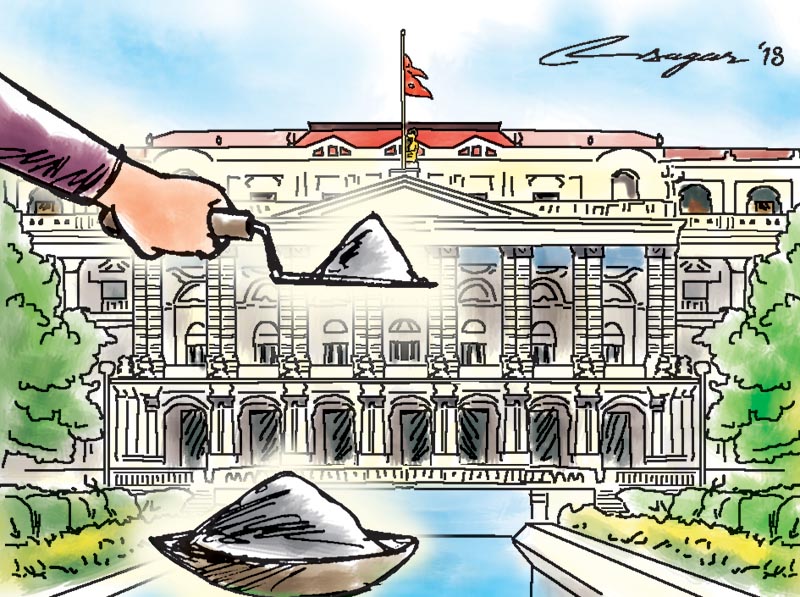Monumental challenge: Reconstruct or retrofit?
It is of utmost importance to note that how three monuments – Bagh Durbar, Singha Durbar and Gaddi Baithak – which are of Greco-Roman forms received three sharply distinct intervention measures after the Gorkha earthquake
Of late, three different benchmarks have been set for Nepal’s heritage sector. First is the decision of the Department of Archaeology to reconstruct Bagh Durbar. Second is the decision of the same authority to retrofit Singha Durbar. And third is the completion of “renovation” of the Gaddi Baithak.
“Renovation” is quite often misunderstood by many as “retrofitting”.
“Retrofitting” incorporates strengthening measures against the likely forces, but “renovation” means restoring the structure back to the stage when it was untouched by any external force – such as an earthquake.
It is of utmost importance to note that how three similar structures, which are of Greco-Roman forms from the structural engineers’ point of view, received three distinct intervention measures after the Gorkha earthquake.
The Greco-Roman architectural forms are not native to Nepal and primarily come from South Eastern Europe. Greek, Italian and Portuguese scientists have widely discussed, assessed and experimented with the current understanding of the behaviour of such structures and interventions. A significant number of intervention measures including innovative retrofitting measures can be found across the literature spectrum of scholastic publications. In Nepal also, quite a few works have been published after the Gorkha earthquake.
The research that I was involved in used forensic structural engineering approach and modelling techniques to identify the vulnerability and performance scenario of heritage structures. The conclusion depicts that amongst the heritages and monuments in Nepal, Greco-Roman are the most vulnerable forms.
Such structures’ performance would be so inferior with no conformity of “life safety” that this incorporates minor damage in the structure but the life of occupants is marked safe, is guaranteed. The implication is that utilising utmost knowledge to strengthen the structures with internationally justified techniques supported by numerical validation.
I co-worked with two of the great structural engineers of Nepal – Rabindra Adhikari and Pratyush Jha – for the Bagh Durbar monument and we found that retrofitting could effectively address current expectations. But dilemmas remain – the dilemma of longevity, dilemma of material degradation rate, the dilemma of current understanding and capacity of numerical modelling, the dilemma of dynamic tests based results, and so on. These are real dilemmas in Nepal as we practise marginal structural engineering.
Let’s look at this question: why steel beams were inserted (during reconstruction) after the 1934 earthquake?
The answer is very simple: the contemporary construction technique was dynamic and people easily adopted it without compromising the aesthetics and values. Is steel intrusion against conservation? If that’s true, why the octagonal temple is (majestically) standing right in front of the 55-window palace in Bhaktapur?
The problems lie equally in the conservationists and structural engineers’ arenas. Conservationists believe that the “sacred soil of Kathmandu Valley” can sustain any sort of force for eternity. The structural engineers believe that retrofitting is possible, but reconstruction is also possible. In reconstruction, tests are first required and then modelling should justify the decision. The wisest solution is: reconstruct the Greco-Roman monuments rather than retrofitting them.
Several measures are available that can be used in such a way that aesthetics and values remain intact. If the people in 1935 could easily adopt the development and endorsed structural integrity and better seismic performance, why this generation should resist the dynamics?
Modernity does not mean just replacing everything with reinforced concrete; it is finding sustainable solutions amongst the traditionally used materials, and surely, there are quite a few options like improving the traditional surkhi lime mortar proportions, timber connections and timber-lacing, creation of mass regularity, provision of decorative supports which could also contribute in structural integrity.
It should be a question to the authority that despite the well-known capacity of the consultant, why did they opt to “renovate” Gaddi Baithak instead of “retrofitting” the whole structure? And what are the factors that drastically differed in the interventions amongst the three Greco-Roman monuments?
Monuments in Nepal are facing monumental challenges after the Gorkha earthquake due to self-centric perceptions, deep-rooted mindsets in bureaucracy and involvement of the decision makers as contractors or consultants.
Public opinions, broad consultations and reasoning are being tagged “inappropriate” just for the sake of vested interests of a handful of people. The problem is with the formulation of unjustified conclusions, as many did after the Gorkha earthquake. The shaking was so low and many of the so-called experts are over-confident seeing the damage level. But there is no guarantee that the shaking would be of the same strength or even smaller if the disaster strikes again.
Gautam, a researcher in structural earthquake engineering, has conducted studies on seismic performance and vulnerability of heritage structures in Nepal






